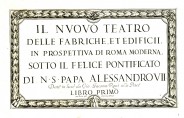
The changes made by Gregory XIII, Sixtus V and Alexander VII to Piazza del Popolo
The view by Giovanni Battista Falda shows Piazza del Popolo after sixteenth-seventeenth century works commissioned by Gregory XIII, Sixtus V and Alexander VII. Actually you can see the fountain by Giacomo della Porta, got placed in the middle of the square in 1573, prior to 1575 Jubilee, by pope Gregory XIII; the Egyptian obelisk from Circus Maximus, which got erected in 1589 by Sixtus V; the interior façade of Porta del Popolo, restored by Gian Lorenzo Bernini on behalf of Alexander VII, who also entrusted him with a mandate to work on the basilica of Santa Maria del Popolo, erected in XI century by Pascal II and rebuilt by pope Sixtus IV for the Jubilee of 1475.
Giovanni Battista Falda, Piazza del Popolo abbellita da n.s. papa Alessandro VII, in: Id., Il nuovo teatro delle fabriche et edificii in prospettiva di Roma moderna..., vol. I, Roma 1665